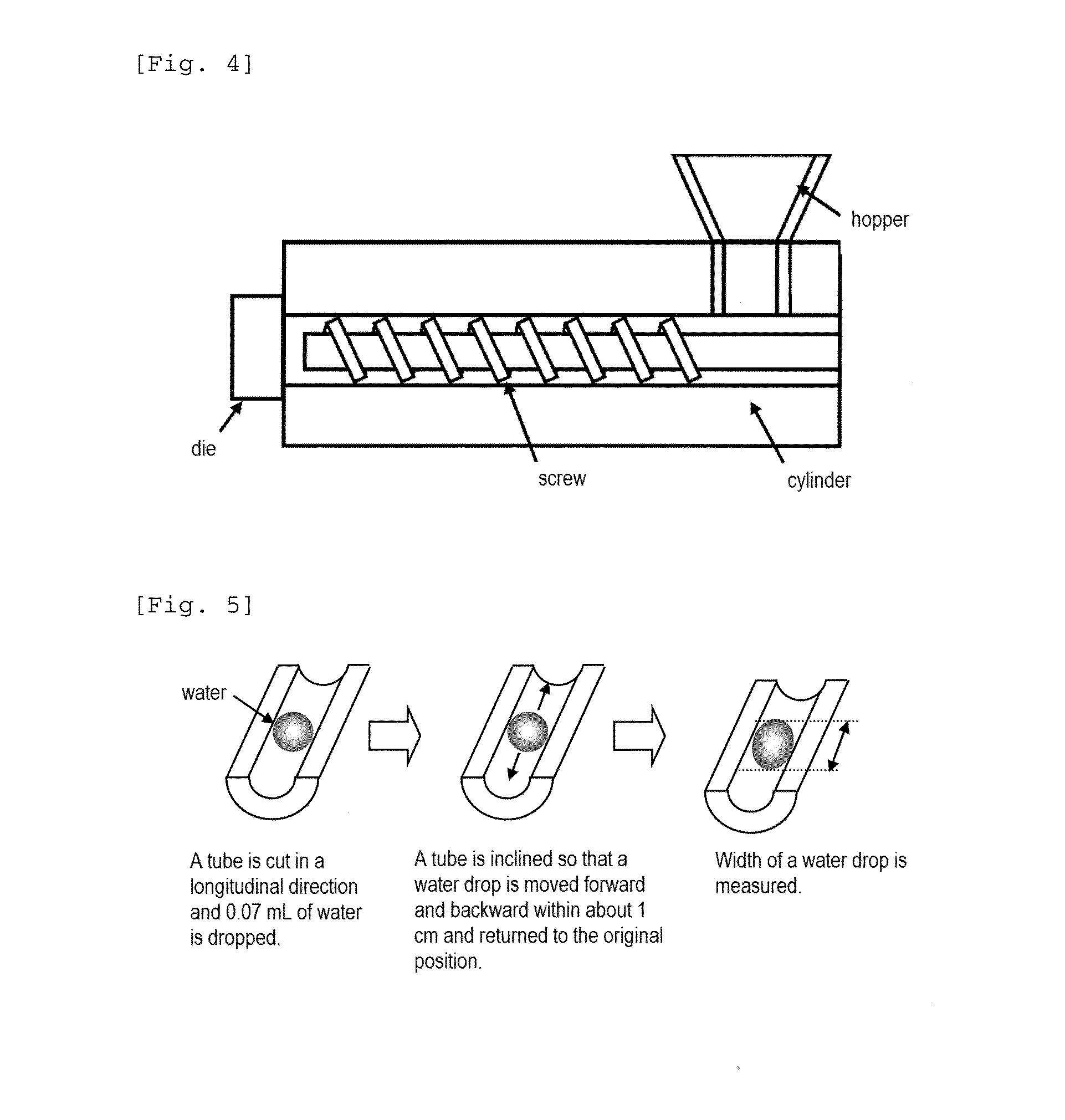Pellet-shaped composition for medical use, and molded product
a composition and pellet technology, applied in the field of pellet-shaped composition for medical use, can solve the problems of insufficient antithrombotic property, turbidity generation, appearance defect, etc., and achieve the effects of excellent antithrombotic property, high hydrophilicity, and good appearan
- Summary
- Abstract
- Description
- Claims
- Application Information
AI Technical Summary
Benefits of technology
Problems solved by technology
Method used
Image
Examples
example 1
[0109]A polyvinyl chloride resin (number-average polymerization degree: 1,000) (10 kg), 1.0 kg of DOP and 5 g of a (meth)acrylate copolymer 1 were charged and kneaded at 155° C. for 3 hours. Then, pellets were prepared at 160° C. and 100 rpm using a biaxial extruder. The resulting pellets were supplied to a supplying part (hopper) and transferred into a cylinder. Screw having compression ratio of 4 was rotated at 56.0 rpm and the pellets were transferred to the front area of the cylinder by melting them at the cylinder temperature of 170° C. The resulting melted resin was extruded from spiral dies of the outlet area of the cylinder. Temperature of the resin at the outlet area of the cylinder at that time was 188° C. The melted resin extruded therefrom was passed through a vacuum water tank having the temperature of 15° C. and then cooled down to nearly the room temperature using the cooling water tank of the same temperature. Degree of vacuum of the vacuum water tank at that time wa...
example 2
[0110]A polyvinyl chloride resin (number-average polymerization degree: 2,000) (10 kg), 3.0 kg of TOTM and 10 g of a (meth)acrylate copolymer 2 were charged and kneaded at 155° C. for 3 hours. They were further subjected to a treatment at 160° C. and 100 rpm using a biaxial extruder to prepare pellets. The resulting pellets were treated in the same manner as in Example 1 to prepare a tube.
example 3
[0111]A polyvinyl chloride resin (number-average polymerization degree: 2,500) (10 kg), 5.0 kg of DOP and 100 g of a (meth)acrylate copolymer 3 were charged and kneaded at 155° C. for 3 hours. They were further subjected to a treatment at 160° C. and 100 rpm using a biaxial extruder to prepare pellets. The resulting pellets were treated in the same manner as in Example 1 to prepare a tube.
PUM
| Property | Measurement | Unit |
|---|---|---|
| molar ratio | aaaaa | aaaaa |
| outer diameter | aaaaa | aaaaa |
| temperature | aaaaa | aaaaa |
Abstract
Description
Claims
Application Information
 Login to View More
Login to View More - R&D
- Intellectual Property
- Life Sciences
- Materials
- Tech Scout
- Unparalleled Data Quality
- Higher Quality Content
- 60% Fewer Hallucinations
Browse by: Latest US Patents, China's latest patents, Technical Efficacy Thesaurus, Application Domain, Technology Topic, Popular Technical Reports.
© 2025 PatSnap. All rights reserved.Legal|Privacy policy|Modern Slavery Act Transparency Statement|Sitemap|About US| Contact US: help@patsnap.com



